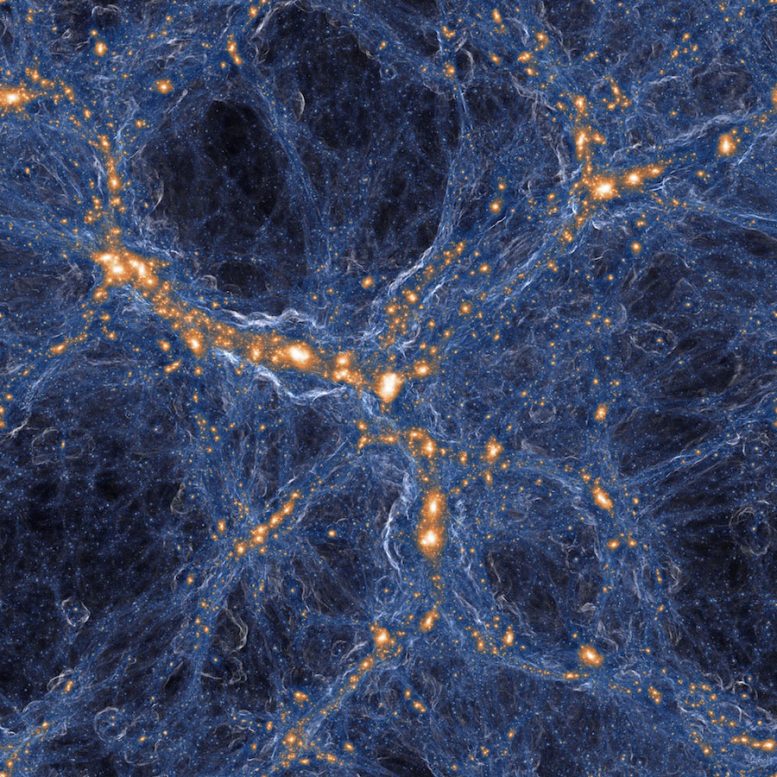
Computer simulation of a region of the universe wherein a low-density “void” (dark blue region at top center) is surrounded by denser structures containing numerous galaxies (orange/white). The research done by Becker and his team suggests that early in cosmic history, these void regions would have been the murkiest places in the universe even though they contained the least amount of dark matter and gas. Credit: TNG Collaboration.
A team of astronomers led by George Becker at the University of California, Riverside, has made a surprising discovery: 12.5 billion years ago, the most opaque place in the universe contained relatively little matter.
It has long been known that the universe is filled with a web-like network of dark matter and gas. This “cosmic web” accounts for most of the matter in the universe, whereas galaxies like our own Milky Way make up only a small fraction. Today, the gas between galaxies is almost totally transparent because it is kept ionized– electrons detached from their atoms–by an energetic bath of ultraviolet radiation.
Over a decade ago, astronomers noticed that in the very distant past — roughly 12.5 billion years ago, or about 1 billion years after the Big Bang — the gas in deep space was not only highly opaque to ultraviolet light, but its transparency varied widely from place to place, obscuring much of the light emitted by distant galaxies.
Then a few years ago, a team led by Becker, then at the University of Cambridge, found that these differences in opacity were so large that either the amount of gas itself, or more likely the radiation in which it is immersed, must vary substantially from place to place.
“Today, we live in a fairly homogeneous universe,” said Becker, an expert on the intergalactic medium, which includes dark matter and the gas that permeates the space between galaxies. “If you look in any direction you find, on average, roughly the same number of galaxies and similar properties for the gas between galaxies, the so-called intergalactic gas. At that early time, however, the gas in deep space looked very different from one region of the universe to another.”
To find out what created these differences, the team of University of California astronomers from the Riverside, Santa Barbara, and Los Angeles campuses turned to one of the largest telescopes in the world: the Subaru telescope on the summit of Mauna Kea in Hawaii. Using its powerful camera, the team looked for galaxies in a vast region, roughly 300 million light years in size, where they knew the intergalactic gas was extremely opaque.
For the cosmic web more opacity normally means more gas, and hence more galaxies. But the team found the opposite: this region contained far fewer galaxies than average. Because the gas in deep space is kept transparent by the ultraviolet light from galaxies, fewer galaxies nearby might make it murkier.
“Normally it doesn’t matter how many galaxies are nearby; the ultraviolet light that keeps the gas in deep space transparent often comes from galaxies that are extremely far away. That’s true for most of cosmic history, anyway,” said Becker, an assistant professor in the Department of Physics and Astronomy. “At this very early time, it looks like the UV light can’t travel very far, and so a patch of the universe with few galaxies in it will look much darker than one with plenty of galaxies around.”
This discovery, reported in the August 2018 issue of the Astrophysical Journal, may eventually shed light on another phase in cosmic history. In the first billion years after the Big Bang, ultraviolet light from the first galaxies filled the universe and permanently transformed the gas in deep space. Astronomers believe that this occurred earlier in regions with more galaxies, meaning the large fluctuations in intergalactic radiation inferred by Becker and his team may be a relic of this patchy process, and could offer clues to how and when it occurred.
“There is still a lot we don’t know about when the first galaxies formed and how they altered their surroundings,” Becker said.
By studying both galaxies and the gas in deep space, astronomers hope to get closer to understanding how this intergalactic ecosystem took shape in the early universe.
Reference: “Evidence for Large-scale Fluctuations in the Metagalactic Ionizing Background Near Redshift Six” by George D. Becker, Frederick B. Davies, Steven R. Furlanetto, Matthew A. Malkan, Elisa Boera and Craig Douglass, 14 August 2018, The Astrophysical Journal.
DOI: 10.3847/1538-4357/aacc73

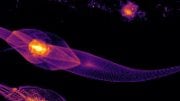
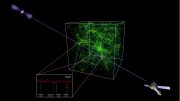

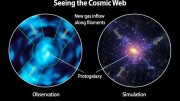
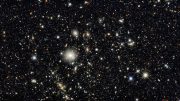

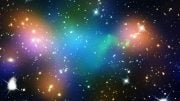
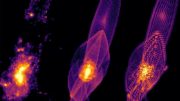
Love this! It reinforces my belief that God is the maker of our universe!!
Take a photo of Earth from where it was positioned 12.5 billion years ago see if so we see anything